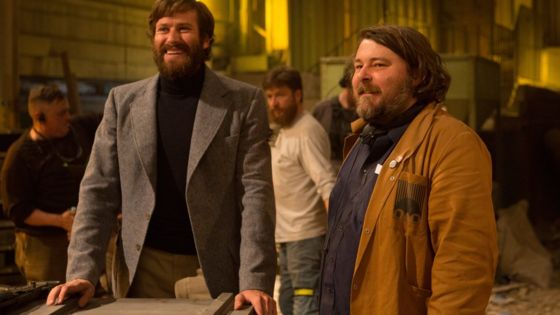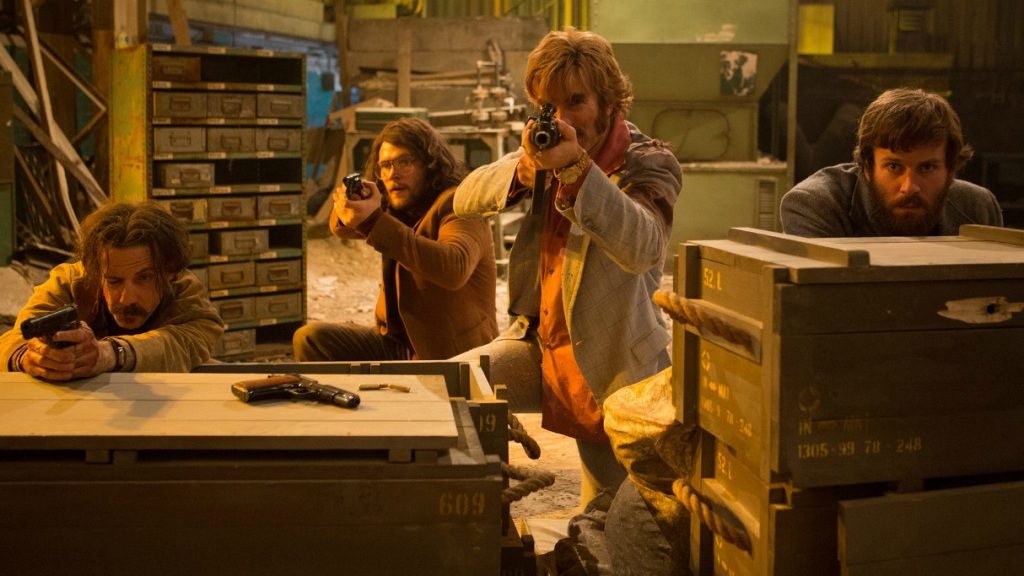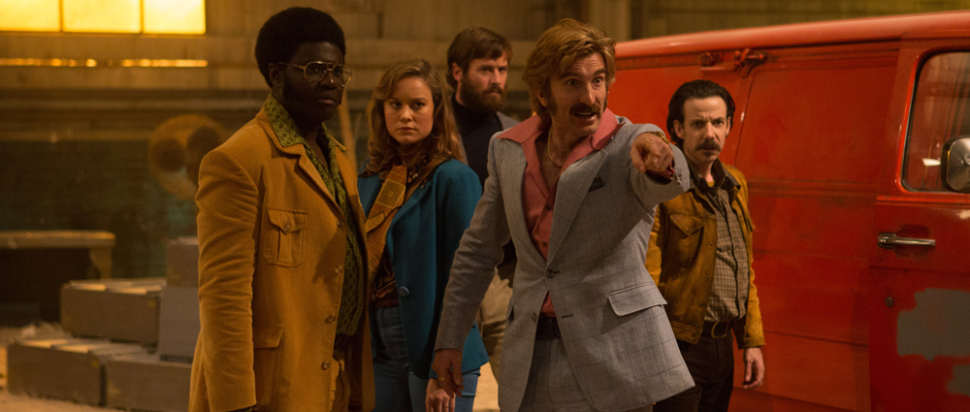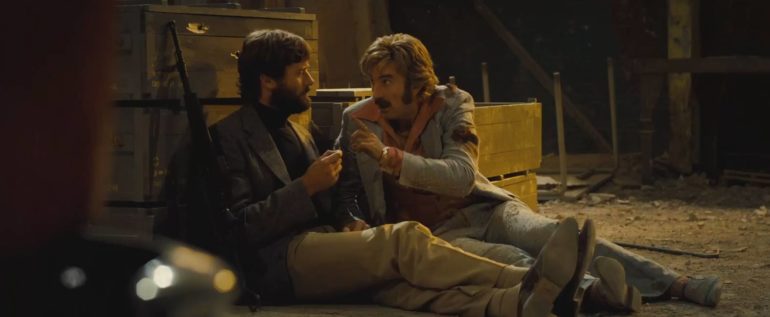SPOILER WARNING: This article contains spoilers of Free Fire‘s plot.
Armie Hammer, how are you? “In goddamn paradise!”, comes a charmingly sarcastic reply.
This answer elicits laughs from his Free Fire co-stars Sharlto Copley and Jack Reynor, and the film’s co-writer/director Ben Wheatley. All are sat around a table to discuss the new film ahead of its European premiere at the 60th BFI London Film Festival. It’s a raw yet oddly balletic and often hilarious shootout, as a warehouse arms deal between Copley’s seller Vernon and Irish gunrunners (led by Cillian Murphy and Michael Smiley) goes awry, leading to a prolonged shooting spree. Brie Larson, Sam Riley, Enzo Cilenti and Babou Ceesay co-star in the mayhem.
All four gentlemen look relaxed; Wheatley is sunk back in his chair in a polo shirt, with Reynor in a similar pose next to him. Hammer leans in and displays a smile of movie-star wattage, while a smart-casual Copley eagerly twizzles honey into a latte. The relaxed mood feeds into a chat that’s full of friendly laid-back badinage between the four.
Despite the pedigree of this talent, the biggest name in much of the advertising has been that of its executive producer, one Martin Scorsese. So, what did he bring to the project? “ His advice was: make the sound mix clearer,” says Wheatley. “You couldn’t hear their voices, so that was the big one from Scorsese. But he loved it. I mean, I went to show him in New York over at Sikelia, which is his production company, and he’s got a screening room there. It’s a bit like like the end of The Wizard of Oz, when you pull back the curtain, go into the room, and he’s there. (Producer) Andy Stark and I had been in New York for about two or three days trying to sort out this meeting and becoming terrified it was never going to happen, and then it happened. The pressure was mounting, mounting, mounting, and then the first thing out of his mouth was that he really loved it. And we just went ‘Oh, thank f**k!’”
Their reaction can’t but get us laughing. The clear camaraderie between the cast and director feeds into Free Fire. It’s often hilarious, but when it’s at the expense of people getting shot, it’s humour of the blackest kind. Not all of that came from the script, though, as Wheatley explains. “The script was a jumping off point for some bits. The film is a fair representation of the script, but there were elements of it that were ad-libbed along the way, so there were spaces for it.” Reynor jumps in, “We all asked for writing credits!” A laugh, and Copley agrees. “Bit of a sore point, really!” Wheatley concedes with a smirk, “I’m just a stickler for keeping all the credit, really! Bits of it were funny, but it became more funny as it went on.”

Yet, for all the laughs on display, Free Fire has the contours of a straight-edged thriller. We ask Wheatley if it started off as such? “To a degree. I mean, there were lots of elements of it that built up over time, and it started with the action side of it, and more procedural. These guys all read a script that I’d written initially, but Amy (Jump, Wheatley’s co-writer, co-editor and wife) hadn’t done a rewrite until later.” A defining trait of the methodology on Free Fire was working through all and any production elements while shooting, even the script. Wheatley again: “Amy was rewriting as we were shooting, so reacting back to rushes and seeing what was going on on set. Obviously, the casting added to it. The script moved on as soon as we knew who it was, ‘cause we tend to rewrite to fit people’s voices.” Hammer vouches for the on-set rewrites. “Shit just started happening where it was written, then they’d finish a scene and you’d see everyone over in the corner laughing and going ‘That’s really funny!’, and I don’t even know if it was intended to be!”
Wheatley gives an example of how the tone of the film evolved. “One of the things I remember specifically was with Sharlto, when we made the decision that Vernon was really just a bit shit. Very early on, Sharlto gave me two options, like ‘I can play this like a real hard-arse ex-military highly-trained killing machine, or I can be a bit rubbish.’ And I thought, it’s quite funny that he can’t shoot straight, and it helps us that he can’t. And so that’s the road we went down.” Copley agrees. “That tonally also made a difference, and I remember talking to you (Ben), and you saying exactly what you’re saying now, like you wanted to go more comedic than you’d started. So, that was where that came from; he let us make a lot of funny stuff. All of us were looking for moments of humour, which we didn’t necessarily know was going to make it.”
So, how does the director decide what to use? “In the cut, Amy and I always look for… Y’know, people will muscle their way into the edit by performance, is how we always work. It’s quite democratic like that. If you’re good, you get more shots! Which I think you all can vouch for!” Gesturing to his cast, Hammer responds “I thought I got cut out a lot!” An explosion of laughter from all at the table later, and Wheatley returns to the wisdom of his method. “You just think ‘Thank God, it’s great!’ You want that. And also, when you have a cast like this, why fight it? You don’t wanna stop ‘em being good. You don’t get cross about it; you encourage it!” Hammer, quick as a flash, doesn’t miss an opportunity for self-deprecation. “We look ridiculous and goofy anyway! Just let us be ourselves!”
Of course, the cast are bringing those aspects of themselves to characters. We ask about the research they did to prepare. Hammer, in the role of smoothie middleman/overseer Ord, goes first. “I looked more into Vietnam kind of stuff. There was a backstory that we decided Ord would have is that he had experience in Vietnam, be it Special Forces or whatever, so he’d seen some shit and lived through some shit. Now, when people are kind of firing around him, he’s kinda like ‘It’ll work itself out. I’ve made it through worse. I’m sure it’ll be fine, so I might as well smoke a joint.’ So it was a lot of looking through Vietnam, what they had to do, and the training they would have in any sort of elite unit in ‘Nam. This guy who comes back, and is now supposed to be this hired gun, and to help Vern make this deal, who’s just preoccupied with hiding in corners!” Wheatley concurs with Ord’s cautious point of view. “He knows how dangerous it is. He’s more realistic and pragmatic. For me, I remember playing video games, and going doing paintball and things, and thinking the skills would transfer!” This sets his cast off laughing again. “If you don’t wanna get killed, you need to hide.”

Reynor plays Harry, one of the lower-level grunts whose anger (pardon the pun) triggers the action. He found inspiration a little closer to home. “Well, I think my character’s just a bit of a toerag, really. I thought to myself, ‘Right, what are the scumbags in Dublin that I know, like? And how can I make an American one of those?, and that’s pretty much the long and short of it!”
Copley is similarly unencumbered by precision in his character work for Vernon. “I knew a lot about the South African military guys during that period from other projects that I’d done research on, but it’s only relevant talking to Ben a little bit about how he could be, and once we decided to make him a little less competent, and a more-talk-and-less-action kind of guy, it became less important to be specific to the time or anything like that. Though there’s a lot of stuff that’s grounded in reality, I didn’t have to do any specific research.” Wheatley enquires “Didn’t run any guns from South Africa, did you?” They’re cracking up again.
Vernon’s aim may be poor, but everyone is in awe of Hammer’s talents with a gun. Copley leads the praise. “Armie had done so much military stuff before, like shooting. I also could shoot, but Armie’s incredible with guns.” Even that fed into the film, as Wheatley adds, “That bit when your gun jams. It’s in the film, when it jams for real, and Armie just strips it and puts it back together again. We were all just watching going… (holds mouth agape), and the armourer was going, ‘What did you just do?!’” Copley agrees. “That was also why I opted to make Vern shit. I was like, “I’m not gonna compete with this guy!’” Few could compete with Hammer in the amount of films he makes either. Hammer is in three major films at the London Film Festival, with Nocturnal Animals and The Birth of a Nation also showing. (Wheatley declares it ‘The Armie Hammer London Film Festival!’ Hammer’s response? “I need a nap!”)
This leads to the question of scheduling and the rigours of the shoot. Free Fire arrives just over a year after High-Rise premiered. How did Wheatley manage such a quick turnaround? “The script was written a long time ago,” he explains, “but the film itself started on the day we delivered High-Rise, so we didn’t stop; we did them back to back. We gave the final print in for High-Rise, and the next day I was designing the location. But it was quick. Because of the way we shot it, we edited it on set, and it was so planned, the actual edit didn’t take that long. The High-Rise edit took f**king ages because it was complicated, but this was something about, 6-8 weeks.” Hammer interjects, “Can I touch on the editing on set thing? I’ve never seen any director ever do this…” We’re returning to the earlier discussion of the Brighton shoot’s on-set practicalities. As Hammer describes it, Wheatley assembled his edit on the set. “He literally has a mini edit bay built on set, with a feed coming right from the camera. As the information is coming, he’s editing in real time, but he’s not going ‘OK, hold on, I want to cut that and put that…’. No, he’s going… (impersonates machine gun), and at the end of the day he’d watch it and go ‘OK, we need a quick shot of the gun. We don’t have that; we need that!’ So we were really shooting to service the edit. And on the last day, he probably had his assembly done!” “Then I go home and my wife just threw it all out!”, laughs Wheatley.
Reynor remembers that editing process in disbelief. “We’d shoot a scene in the morning, go to lunch, come back an hour later and watch what you’d just done in the morning, cut. F*king insane!” How many takes would you have to do to be able to assemble a cut this way? “Lots.” says Wheatley, “But I watch it all as I’m shooting it, so I know what it is. It really helps with action, because the performance in action isn’t as important for an assembly.” Hammer feigns indignance with a smile, “He said, in front of his actors!” “I mean, it is later on,” the director clarifies. “It’s fine-tuned later, but it’s more to make sure that all those angles have been shot so that the logic of the thing makes sense. But drama performances are a different thing. That takes much more time, scouring through the takes to get it. It’s the nightmare that only happens very rarely, but that you’d cut a scene together and go, ‘OK, where’s the close-up of Sharlto?… Oh, f**k, there is no close-up!’ But with an action thing, it’s like Armie said. You need someone picking something up rat-a-tat, or else that story’s not gonna get told. In the traditional way, you just cover it by shooting and shooting and shooting, but we just didn’t have that luxury. It was a B-movie, done on a B-movie schedule, so it had to all be right.”

Even with a tight schedule, the cast still found time for fun. “We went to the shop a few times, with like blood and shit all over us.”, says Reynor. We’d go into Sainsbury’s…”, at which point Hammer takes over, “And they’d literally look up and go… (looks shocked).” Reynor exclaims, “Especially with the size of him as well!” (Hammer stands 6’5”). Hammer continues, “I had like a bullet hole in my shoulder that’s oozing blood, and Jack would be covered in rubble, and we’d go, ‘Excuse me, where are your ping-pong tables?’” Reynor sums it up thus: “It was madness.”
As is so often the case, a film centred on chaos requires a lot of organization. Wheatley clearly planned his film and his set enough that a lack of rehearsal wasn’t a problem. “There’s not many films there’s any rehearsal, to be fair,” he says. “It’s not like theatre.” Reynor certainly enjoyed the experience of the single location. “I think once we got into the environment, and once we got comfortable with being on the ground and in the rubble, it quickly became apparent that it was kind of blocked out in segments, that there were different areas in which action was going on. For instance, the three of us spent a lot of time by the ammo crates, whereas Cillian, Sam and Smiley all sat over by the pillar, so there were all these little groups. Then we cut, we all come together to tell our shit jokes, and then we’d all go back to our sides of the battlefield! It just worked itself out naturally very quickly.”
Hammer appreciates the pre-planning. “There was also something really great that Ben did with Laurie (Rose), his DoP, and Barry (Conroy), the guy who lit the movie. The whole movie was already pre-lit by the time we got there, so we could go, “Hey, can I run over there?”, and Ben would go, “Barry, hit that over there”, and Barry would go ‘whoop” on his iPad, and the lights would just go on.” Wheatley embraced new technology to help with the practical aspects “Usually, they have a massive mixing desk, and there’s a guy whose whole job is just the light mixing. But the wifi control of it was new, and it was all remote.” Hammer adds, “And we could go anywhere. If I was like, ‘I wanna run to that corner’, he’d go, ‘Light it up.’ There was no setups or huge changes.” Copley agrees with the ease it gave the actors. “It’s a real luxury. You don’t get that, really. It’s very rare that you can move as fast as we moved. For actors, especially if you’re doing action films, because action films are usually pretty slow, and you’ll have a big effects component, it just made it very easy. It makes it so easy for the actors when everything’s already there. Sounds basic, but it really does make a difference.”
Easy as the shoot might have been, there’s little that could be easy about the stunts. A late scene sees Copley’s Vernon have a run-in with a fiery oil spill, and he performed the stunt himself. “We talked about it quite early on,” says Wheatley. “I put the blame for that at Peter Pedrero’s door, the stunt coordinator. I think he egged you on about it.” We turn to Copley “I wanted to do it! I just want you to confess why you left it to the last shot of the film! You did that for insurance.” With a laugh and sly smile, Wheatley says “One reason was to give myself extra time to talk him out of it. The real reason was that if he f**king burnt himself, we couldn’t have shot around it to match the continuity!” Much like the film, it’s cruel but funny, yet Copley understands. “I’d have done the same thing. If I was in your shoes, and some stupid actor said, ‘I wanna do the burn myself’, I’d do it last.”
Wheatley explains the stunt procedure. “There’s also a massive amount of… you could say safety procedure, you could say theatre, around how it works. It’s like you have to have 40 minutes gap either side, and then rehearse and then go back. That one shot took around four hours.” Copley confesses, “I did start that morning with pangs in my stomach when I saw how seriously the stunt guys were all taking it. I was like, ‘This is a bigger deal than I imagined!’” At this point, Hammer quips, “I like that we’re talking about Health and Safety, and immolating someone at the same time. ‘We have to be really safe while we light you on fire!’”
A memorable point in the denouement sees Sam Riley’s Stevo succumb to a nasty fate, and that needed a lot of work. “The van running over Sam Riley’s head is real. It’s not CG,” explains Wheatley. “It was taken from a Penn and Teller trick, in that you counterbalance the wheels so that the front wheel is a dummy. The real van is weighted on one side, so you can run over someone. That was cool, and it’s all in camera.” Not everyone was thrilled at the prospect of running someone over with a van, as Wheatley recalls. “Sam’s wife saw the van out back, and she wasn’t best pleased about it! She was worried, so she said to production, ‘It’s not gonna happen. He’s not going under that thing!’ That got back to me, so I said, ‘I’ll do it! I’ll test it.’ I’m not a particularly brave person, but I saw ‘How bad could it be?’ But you have to turn your neck with it so it doesn’t break your neck!” This elicits winces from everyone in the room, but Wheatley tries to laugh it off.
“So I’m lying there, and the whole crew’s just watching, and I thought, ‘Oh, this is bad, man.’ Cue another explosion of laughs from all present. “And this fucking wheel’s coming towards me, and it looks really real! And they’re all taking photos and cheering, and I’m absolutely f**king traumatised. I’m like ‘There you go, Sam! It’s fine!’” At this point, Wheatley whips out his smartphone and rummages through his videos. We’re all upstanding and leaning in to watch the video, and sure enough, a van runs over his head. Every jaw in the room is hanging open, and most are emitting expletives.
Coming down from that rush, we ask Wheatley how he decides what scripts to get made. With their company, Rook Films, Wheatley and Jump have produced most of his features since Down Terrace, plus the likes of The Greasy Strangler and The Duke of Burgundy. “The film that gets the most traction gets made,” he explains. “I mean, if it finds its way through the system and people wanna pay for it, that’s the film that’ll get made. You don’t know what that’s going to be at any given point, so we always have low-budget movies, mid-budget movies and expensive movies, all out and about in the world, seeing if they can become movies. I think that’s the sensible way to do it, otherwise you’ve got one passion project, which is a recipe for not working for seven years, and maybe never doing that film and having to jump onto something else. I had a meeting the other day, and they asked, ‘Why d’you want to do this film now?’ I said, ‘Well, I want to do all the f**king films!’ It’s not that this one particularly better than the others; it’s just that we like all of them, otherwise we wouldn’t write them!”
Free Fire is in cinemas now. Read Scannain‘s review here.

